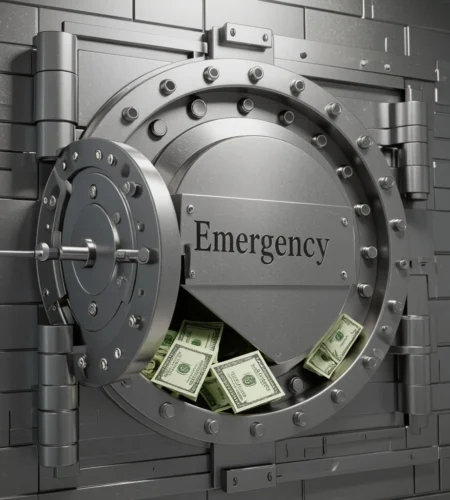There’s something deeply empowering about watching your savings account hit that magical four-figure mark for the first time. Maybe it’s the way your shoulders relax when unexpected expenses pop up, or how differently you walk into salary negotiations knowing you have options. The truth is, when you’ve built that first crucial emergency fund, you’re not just saving money—you’re buying freedom.
For solo professionals, that first $6,000 emergency fund isn’t just recommended financial advice. It’s the foundation that transforms your entire relationship with money, career choices, and life decisions. Because when you’re operating on a single income without a partner’s financial backup, this fund becomes your safety net, your confidence builder, and your ticket to genuine independence.
Table of Contents
Why $6,000 Hits Different When You’re Flying Solo
Here’s what traditional financial advice gets wrong: they assume you have someone to catch you if you fall. As a solo professional, you ARE the safety net. While couples can rely on dual incomes during emergencies, your financial security rests entirely on the foundation you build yourself.
Six thousand dollars represents roughly three months of essential expenses for most solo professionals earning $40,000-$85,000 annually. But the psychological impact goes far beyond the math. This fund transforms you from someone who hopes nothing goes wrong to someone who knows they can handle whatever comes.
The Solo Professional Reality Check: Recent data shows that single-person households face unique financial pressures that make emergency funds even more critical. Without shared housing costs, dual incomes, or built-in financial redundancy, solo dwellers need more robust emergency planning.
What counts as a true financial emergency?
Real emergencies are unexpected, necessary, and urgent expenses that you can’t plan for or delay. Think medical bills not covered by insurance, urgent car repairs needed to get to work, emergency travel for family situations, or sudden job loss.

Not emergencies: Vacations you “need,” sale items you “can’t miss,” or replacing something that’s old but still functional. Your emergency fund isn’t a shopping fund with a fancy name.
The Strategic Building Plan That Actually Works
Phase 1: The Foundation Sprint (Months 1-3)
Target: First $1,000
This isn’t about massive lifestyle changes—it’s about creating momentum. The goal is proving to yourself that you can prioritize your future self over your present wants.
Week 1-2: The Financial Archaeology Dig
- Export three months of bank statements and categorize every expense
- Identify your true monthly essentials (housing, utilities, transportation, food, minimum debt payments)
- Calculate your exact monthly survival number
Week 3-4: Find Your First $200
- Cancel one subscription you barely use
- Sell something gathering dust (that exercise equipment, anyone?)
- Skip takeout twice and cook simple meals instead
- Pocket loose change and small bills for one week
Months 2-3: Build the Momentum
Set up automatic transfers of $250-350 monthly to a separate high-yield savings account you don’t look at daily. This forces consistency without relying on willpower.
Pro Tip: Name your emergency fund savings account something that motivates you personally. “Freedom Fund,” “My Safety Net,” or “Option Money” works better than “Emergency Savings” for maintaining long-term motivation.
Phase 2: The Acceleration (Months 4-12)
Target: $3,000-$6,000
Once you’ve proven you can save your first $1,000, the psychological barrier breaks. Now it’s about optimizing and accelerating without burning out.
Income Optimization Strategy:
- Negotiate your next raise: With emergency funds building, you can negotiate from a position of strength rather than desperation
- Strategic side income: Use skills you already have—freelancing, tutoring, consulting—for an extra $300-500 monthly
- Expense refinement: Review insurance, phone plans, and recurring bills annually for optimization opportunities

The 50/30/20 Solo Modification:
Traditional budgeting advice assumes dual incomes. Solo professionals need modified percentages:
- 50% Fixed Expenses (housing, utilities, transportation, minimum debt payments)
- 20% Emergency + Retirement Savings (higher than traditional recommendations)
- 30% Everything Else (food, entertainment, discretionary spending, additional debt payments)
When Your Emergency Fund Pays for Itself
Three years into building my emergency fund system, I realized something profound: the fund had already “paid for itself” multiple times over, not through withdrawals, but through opportunities it created.
Career Flexibility: When my company restructured last year, I could evaluate the severance package objectively instead of desperately accepting whatever was offered. Having six months of expenses saved meant I could take time to find the right next opportunity.
Negotiation Power: Annual salary negotiations became conversations between equals rather than desperate pleas. When you know you can survive a “no,” you’re free to ask for what you’re actually worth.
Peace of Mind Investment: The mental energy I used to spend worrying about money got redirected toward career development, creative projects, and building the life I actually wanted.
Should I pay off debt or build emergency savings first?
The Technology That Keeps You Honest
Building an emergency fund isn’t about willpower—it’s about creating systems that work automatically, even when motivation wanes.
Automation Excellence:
- Immediate transfer setup: Money moves to savings before you mentally categorize it as “available to spend”
- High-yield savings account: Your emergency fund should earn 4-5% APY while remaining fully accessible
- Separate bank entirely: Keep emergency funds at a different institution to reduce temptation for “emergency” purchases
Progress Tracking Without Obsession:
- Monthly check-ins rather than daily balance monitoring
- Visual progress charts (a simple spreadsheet or app) to maintain motivation
- Milestone celebrations that don’t involve spending the money you just saved

Beyond the Numbers: What This Really Buys You
Your first $6,000 emergency fund purchases something money can’t usually buy: true independence. Not the Instagram version with perfect lighting, but the real thing—the ability to make decisions based on what’s right for you rather than what you can afford in the moment.
Professional Confidence: Walking into performance reviews, client meetings, or job interviews knowing you have options changes everything. You speak differently when you’re not desperate.
Life Design Freedom: Emergency funds let you take calculated risks. Want to freelance? Change careers? Move cities? Your safety net makes exploration possible.
Relationship Authenticity: When you’re not financially desperate, you can build relationships based on genuine connection rather than financial need or convenience.
Quality Sleep: Nothing replaces the peace of mind that comes from knowing you can handle whatever tomorrow brings.
Pro Tip: Track one non-financial metric alongside your emergency fund growth. Maybe it’s how well you sleep, stress levels during unexpected expenses, or confidence in workplace situations. This helps you recognize the true value beyond the dollars.
Your Next 30 Days
Emergency funds aren’t built in motivation bursts—they’re constructed through consistent, intentional choices that compound over time. Your first month sets the foundation for everything that follows.
Week 1: Calculate your true monthly essential expenses. Set up a separate savings account specifically for emergency funds.
Week 2: Identify $200 in expenses you can temporarily redirect toward savings. Set up automatic transfers for at least $250 monthly.
Week 3: Find one additional income source (selling unused items, picking up freelance work, optimizing existing subscriptions).
Week 4: Celebrate hitting your first savings milestone, no matter how small. Plan your strategy for month two.
Your solo living journey isn’t about making compromises—it’s about making intentional choices that support the life you’re building. Every dollar in your emergency fund represents freedom, options, and the confidence to live entirely on your own terms.
After all, true independence isn’t just about living alone. It’s about having the financial foundation to thrive alone, knowing you’ve built something that supports your highest aspirations rather than just your immediate needs.
Use of this website constitutes acceptance of all our disclaimers and legal agreements.

